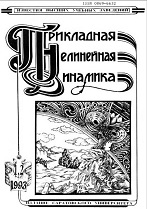|
BIFURCATION IN DYNAMICAL SYSTEMS. DETERMINISTIC CHAOS. QUANTUM CHAOS.
Self-oscillating system generating rough hyperbolic chaos
S. P. Kuznetsov
Saratov Branch, Kotel'nikov Institute of Radio-Engineering and Electronics, Russian Academy of Sciences
Abstract:
Topic and aim. The aim of the work is design of rough chaos generator, whose attractor implements dynamics close to Anosov flow on a manifold of negative curvature, as well as constructing and analyzing mathematical model, and conducting circuit simulation of the dynamics using the Multisim software. Investigated models. A mathematical model is considered that is a set of ordinary differential equations of the ninth order with algebraic nonlinearity, and a circuit representing the chaos generator is designed. Results. A numerical study of the dynamics of the mathematical model was carried out, which confirmed existence of the attractor composed of trajectories close to the geodesic flow on the surface of negative curvature (Schwarz P-surface). A circuit simulation of the electronic generator, in which the dynamics corresponds to the proposed mathematical model, is carried out. The illustrations of the system dynamics are presented in the form of oscilloscope traces, power spectra, pictures of the trajectory flow on the attractor. For the mathematical model, the Lyapunov exponents were calculated and the hyperbolic nature of the attractor was verified by analyzing histograms of the intersection angles of stable and unstable manifolds. Discussion. The proposed electronic generator demonstrates chaos with intrinsic structural stability due to hyperbolic nature of the attractor, which implies insensitivity of the dynamics with respect to small variations in the system parameters, manufacturing imperfections, and interferences. The hyperbolic attractor is characterized by approximate uniformity of stretching and compression for phase volume elements in continuous time, which determines rather good spectral properties of the signal. Although the consideration has been carried out for a low-frequency device, it seems possible to develop and modify the circuit also to create generators of rough chaos in high and ultra-high frequency bands.
Keywords:
dynamical system, chaos, attractor, geodesic flow, Anosov dynamics, hyperbolicity, Lyapunov exponent.
Received: 11.08.2019
Citation:
S. P. Kuznetsov, “Self-oscillating system generating rough hyperbolic chaos”, Izvestiya VUZ. Applied Nonlinear Dynamics, 27:6 (2019), 39–62
Linking options:
https://www.mathnet.ru/eng/ivp348 https://www.mathnet.ru/eng/ivp/v27/i6/p39
|

| Statistics & downloads: |
| Abstract page: | 155 | | Full-text PDF : | 56 |
|




 Contact us:
Contact us: Terms of Use
Terms of Use
 Registration to the website
Registration to the website Logotypes
Logotypes








 Citation in format
Citation in format 